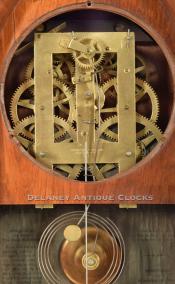Brewster & Ingrahams. Bristol, Connecticut. This is an unusual example in that the movement features cast iron spring holders and a rack and strike striking system. HH-122.
This rare beehive mantel clock was made by the Brewster & Ingrahams Clock Company of Bristol, Connecticut. This early example of the beehive form features Kirk’s Patent cast iron spring holders and a rack-and-snail striking arrangement. This is a very difficult combination to find.
The brass-constructed movement is a time-and-strike design. It is coil spring powered and designed to run for eight days on a full wind. The coil springs are held in a cast iron holder designed and patented by Charles Kirk. The rack-and-snail strike work is located between the plates. This clock strikes each hour on a wire gong mounted to the backboard. The front plate of the movement is die-stamped by the manufacturer. The gearing is brass and features rolling pinions. The pendulum lead bob is covered or faced in brass.
The pine case is veneered rosewood and retains a slick finish. The front of the clock is fitted with a door. This door features a lock that is opened with a key. A decorative bone escutcheon frames the keyhole. The lower section of the door is fitted with a period mirror. The upper section has clear glass. Through this, one can view the clock’s painted wooden dial. The backboard is covered or, more appropriately, retains its original paper, which is pasted onto the surface.
This clock was made circa 1843 and stands approximately 19 inches tall.
Inventory number HH-122.














